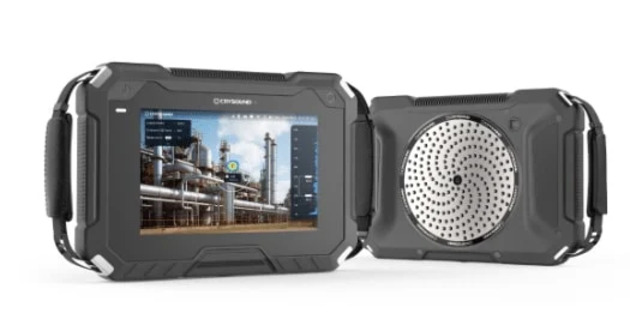
Sound plays a critical role in many industries, from manufacturing to automotive engineering. The ability to not only measure but also visualise sound can provide engineers and technicians with valuable insights for improving product performance, safety, and user comfort. This is where the acoustic camera comes into play. By transforming sound into a visual representation, it allows for rapid identification of noise sources and helps guide effective solutions.
What is an Acoustic Camera?
An acoustic camera is a specialised device that uses an array of microphones combined with advanced software to locate and visualise the origin of sounds. The data it collects is processed to produce an image or video, where colours or patterns indicate the intensity and position of the noise. This enables users to “see” sound in real time.
Unlike traditional sound measurement tools that provide only numerical data, an acoustic camera adds a spatial dimension to noise analysis, making it easier to detect specific problem areas. Whether it’s a rattling panel in a car or an air leak in a piece of machinery, the technology makes identifying sources far more efficient.
How Acoustic Cameras Work
Acoustic cameras operate by using beamforming technology. Multiple microphones capture sound waves, and the differences in the time it takes for each microphone to receive the sound are calculated. This information is then processed to triangulate the position of the sound source. The result is a visual overlay, often superimposed on a photo or video of the test environment, showing precisely where the sound is coming from.
The sensitivity and accuracy of the camera depend on the number of microphones, their arrangement, and the processing algorithms. Modern systems can detect a wide range of frequencies, making them suitable for various applications.
Applications in Automotive Engineering
One of the most prominent uses of acoustic cameras is in the automotive sector. Vehicle manufacturers are under constant pressure to produce quieter, more refined vehicles while still meeting performance targets. Acoustic cameras provide an efficient way to detect and resolve noise issues during design and testing phases.
- Cabin Noise Diagnostics
Inside a vehicle, numerous components can generate unwanted noise, from dashboard panels to seat mechanisms. By placing the camera in the cabin during operation, engineers can visualise which areas produce the most sound and make targeted adjustments. - Exterior Noise Compliance
Regulations often require vehicles to meet specific external noise limits. Acoustic cameras allow for quick pinpointing of problematic areas during drive-by tests, whether the source is the exhaust, tyres, or aerodynamic features. - Electric Vehicle Development
Electric vehicles have altered the noise profile of cars dramatically. With the absence of engine noise, other sounds like wind and tyre noise become more apparent. Acoustic cameras are invaluable in identifying these issues so manufacturers can address them without compromising the driving experience.
Beyond Automotive: Other Industry Uses
Acoustic cameras are not limited to the automotive world. They have applications in industrial manufacturing, building acoustics, aerospace engineering, and environmental noise monitoring. In factories, they can detect mechanical faults by identifying unusual noise patterns. In construction, they help locate air leaks or assess building insulation performance.
Advantages Over Traditional Methods
Traditional noise detection methods can be time-consuming, often requiring extensive manual testing to locate a sound source. An acoustic camera, on the other hand, can identify multiple noise sources simultaneously and in real time. This not only speeds up diagnostics but also reduces the risk of overlooking subtle or intermittent noises.
The ability to visualise noise also aids in communication. Engineers can show clear images or videos to stakeholders, making it easier to explain problems and justify proposed solutions.
Choosing the Right Acoustic Camera
The choice of an acoustic camera depends on factors such as the frequency range of interest, the environment in which it will be used, and the desired level of portability. Some systems are designed for laboratory conditions, while others are rugged enough for fieldwork. Many modern units integrate with tablets or laptops for easy control and data analysis. For those looking for a variety of professional options, a dedicated acoustic camera supplier can provide solutions tailored to specific applications.
The Future of Acoustic Imaging
Advancements in processing power and microphone technology are making acoustic cameras even more powerful and accessible. Newer models offer higher resolution, greater frequency range, and improved noise suppression, enabling them to operate effectively even in challenging environments. As artificial intelligence becomes integrated into these systems, automated detection and classification of sound sources will become more common, further streamlining the diagnostic process.
Conclusion
Acoustic cameras have revolutionised the way industries detect and analyse noise. By combining precise measurement with visual representation, they enable faster, more accurate identification of sound sources, saving both time and resources. From improving vehicle comfort to detecting faults in machinery, their role continues to expand, making them an essential tool for modern engineering and design.